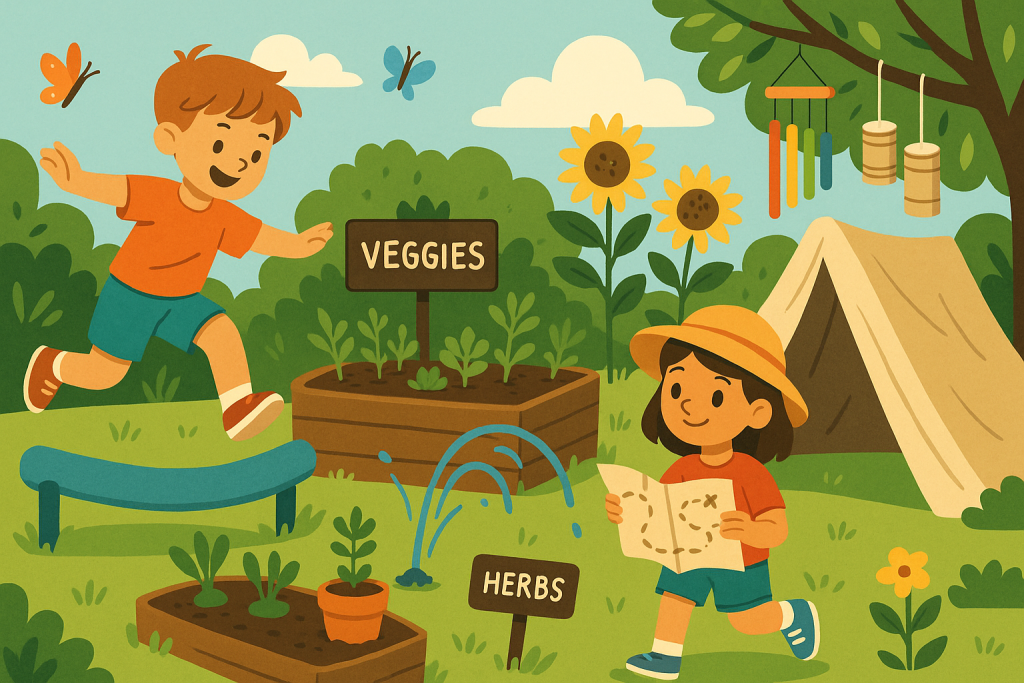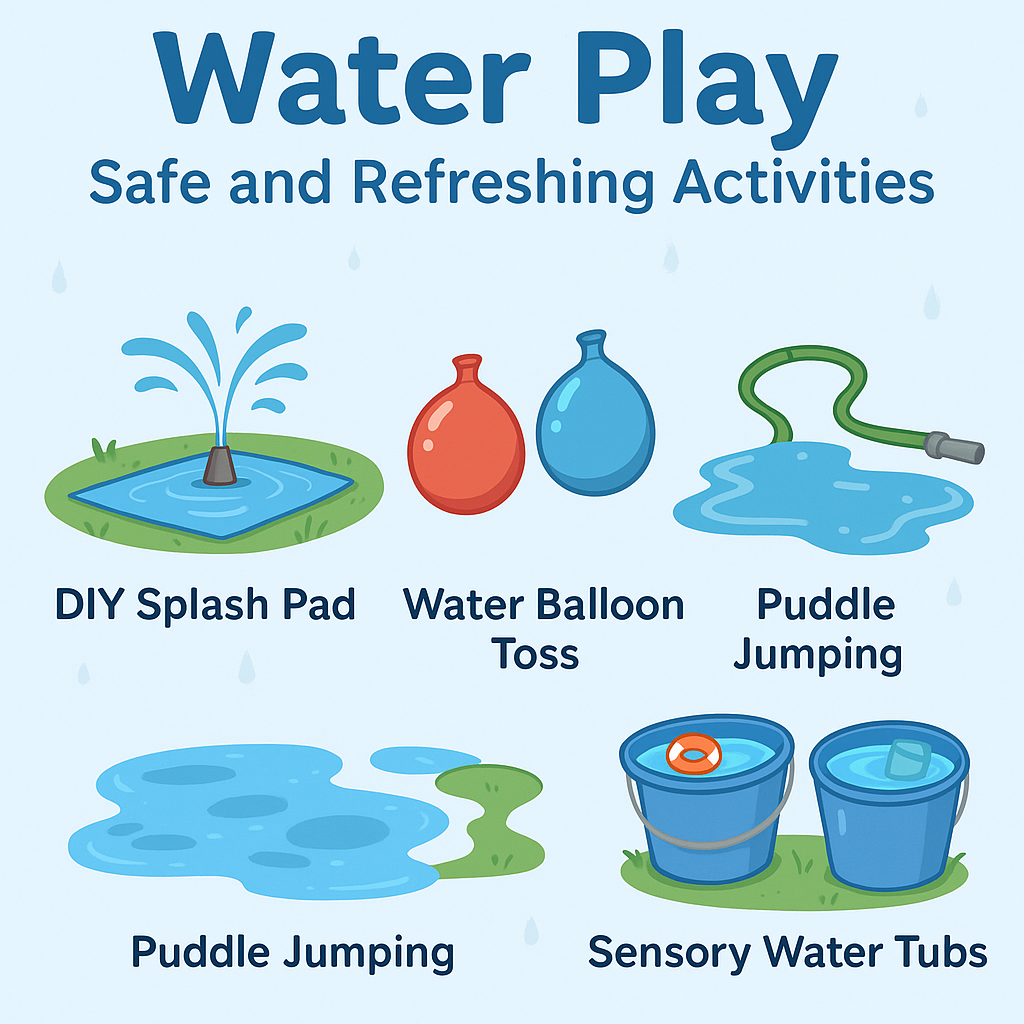15 Creative Ways to Keep Kids Active and Happy in Your Garden
Why Outdoor Play in the Garden Matters for Kids
Encouraging your children to play outside is more than just a way to keep them occupied. Time spent in the garden fosters healthy physical development, enhances social skills, and stimulates creativity. In an age where digital entertainment often takes priority, transforming your garden into a haven for active play is a proven strategy to promote your child’s well-being.
Studies show that children who engage in outdoor play regularly experience improved motor skills, lower stress levels, and higher academic performance. Even small, simple gardens can offer countless opportunities for fun and learning. No matter your outdoor space’s size, you can create an environment where kids are motivated to move, explore, and use their imagination.
In this comprehensive guide, we’ll share 15 easy and creative garden activities to keep your kids active, entertained, and happy. Each idea is designed to be adaptable, budget-friendly, and suitable for a range of ages. Let’s turn your simple garden into the ultimate playground!

1. Backyard Obstacle Course Adventures
Transforming your garden into a backyard obstacle course is an excellent way to channel your child’s energy and develop their agility. This activity is simple to set up and can be customized with household items.
DIY Obstacle Course Ideas
Use what you have around the house: hula hoops, buckets, cones, ropes, old tires, and pool noodles make fantastic course elements. Arrange these objects to create stations where kids can jump, crawl, balance, or zig-zag.
- Jumping over lines of pool noodles
- Crawling under chairs or tables
- Balancing on a wooden plank or stepping from stone to stone
- Weaving through cones or potted plants
Time your children as they run the course and challenge them to beat their previous records. This adds a competitive edge and encourages repeat play, which is excellent for building endurance and confidence.
Tips for Safe and Fun Play
Safety should always come first. Use soft materials where possible and avoid sharp edges. You can change the course layout regularly to keep things fresh and engaging, and even invite friends or siblings for relay races to build teamwork and communication skills.
2. Garden Treasure Hunts for Explorers
Organizing a garden treasure hunt is a classic way to ignite your child’s curiosity and get them moving. Whether you have a large lawn or a cozy patio, this activity is endlessly adaptable and provides hours of entertainment.
How to Set Up a Treasure Hunt
Create a list of simple items for your children to find: painted rocks, flower petals, pinecones, or even small toys you hide beforehand. Write clues or draw a treasure map for older children, while younger ones can search freely with a checklist.
- Theme ideas: pirate treasure, nature scavenger, or fairytale quest
- Include riddles or puzzles for added brain-boosting fun
Offer small rewards or certificates for completing the hunt. This fosters excitement and a sense of achievement while encouraging teamwork if kids play in groups.
Benefits of Treasure Hunting
Treasure hunts promote problem solving, cooperation, and observation skills. They also provide a gentle way to introduce kids to the wonders of nature around them, making every garden adventure educational as well as fun.
3. Classic Ball Games with a Twist
Ball games are a staple of outdoor play, offering countless opportunities for running, jumping, and coordination. They’re easy to set up and adapt to gardens of all shapes and sizes.
Creative Garden Ball Games
Try these ball-based activities to engage your children:
- Garden Bowling: Set up empty bottles and use a soft ball to knock them down.
- Target Throw: Hang up a hula hoop or draw circles on the ground with chalk for kids to aim at.
- Kickball or Mini Soccer: Mark out goals using flower pots or buckets and play a friendly match.
- Balloon Volleyball: Use a string as a net and a balloon as the ball for younger children.
These games help kids build strength, coordination, and teamwork. Encourage them to invent their own variations for added creativity.
Adapting Ball Games for Any Space
If your garden is small, use soft or foam balls to prevent breakages, and set clear boundaries to keep play safe. For larger spaces, add more complex rules or obstacle elements to increase the challenge and excitement.
4. Nature Art: Creative Projects from Your Garden
Combining art and nature is a wonderful way to stimulate creativity while enjoying the outdoors. Encourage your children to use materials they find in the garden for their projects.
Nature Art Ideas
- Leaf Rubbing: Place leaves under paper and rub crayons or pencils over the top to reveal patterns.
- Rock Painting: Collect smooth stones and decorate them with bright colors and patterns.
- Flower Mandalas: Arrange petals, twigs, and seeds on the ground in circular designs.
- Twig Sculptures: Use twigs and string to build simple structures or collages.
Art projects like these encourage children to observe their surroundings closely, developing both fine motor skills and a sense of appreciation for nature.
Making Art Outdoor-Friendly
Set up a shaded area or picnic blanket as an “outdoor art studio.” Use washable paints and non-toxic materials for easy cleanup. Display finished works around the garden to create a personal, ever-changing gallery.
5. Mini Gardeners: Simple Planting Activities
Getting kids involved in planting and gardening is an invaluable way to teach responsibility, patience, and respect for living things. Even the smallest garden can become a learning laboratory.
Easy Gardening Projects for Kids
- Grow-Your-Own Herbs: Plant basil, mint, or chives in pots for children to water and harvest.
- Sunflower Race: Plant sunflower seeds and see whose grows the tallest.
- Mini Veggie Patch: Use a small patch or large containers to grow simple vegetables like radishes, lettuce, or tomatoes.
Involving kids in these projects teaches scientific concepts like growth cycles and sustainability, while providing healthy snacks straight from the garden.
Tips for Success with Young Gardeners
Choose fast-growing or hardy plants for immediate results and minimal frustration. Let kids be responsible for watering, weeding, and even designing their own plant labels. Gardening gloves and child-sized tools help make the experience fun and safe.
6. Water Play: Safe and Refreshing Activities

Water-based activities are a favorite way for kids to stay cool and active, especially during warmer months. With a few precautions, your simple garden can become a splash zone for endless enjoyment.
Water Play Ideas for the Garden
- DIY Splash Pad: Lay out a plastic tarp, add a sprinkler, and let kids run and slide.
- Water Balloon Toss: Fill up balloons for tossing games or gentle water fights.
- Puddle Jumping: Create shallow puddles with a hose and see who can make the biggest splash.
- Sensory Water Tubs: Set up buckets with floating toys and cups for pouring and scooping.
Always supervise water play closely, even when using small amounts of water, to ensure safety for all ages.
Making Water Play Eco-Friendly
Re-use water for plants after playing whenever possible, and avoid using excessive amounts. Teach kids about the importance of water conservation as they enjoy these garden games.
7. DIY Sports Day at Home
Bring the excitement of a school sports day to your garden with easy-to-set-up mini competitions. This is a great way to get siblings and friends involved, encouraging friendly competition and teamwork.
Fun Sports Day Activities
- Sack Races: Use old pillowcases or large bags for hopping races.
- Egg and Spoon Race: Use plastic eggs for less mess.
- Three-Legged Race: Tie ankles together with soft fabric and race across the lawn.
- Bean Bag Toss: Set up buckets or targets and take aim.
Keep score and give out homemade medals or certificates. This boosts motivation and creates lasting memories for your children.
Tips for Running a Smooth Sports Day
Plan a mix of high-energy and calmer activities to include everyone. Prepare a water station and shady rest area, and don’t forget a playlist for added fun! Celebrate everyone’s efforts to keep the mood positive and inclusive.
8. Themed Garden Parties for All Ages
A themed garden gathering can turn a regular day into an adventure. With a bit of imagination, outdoor parties provide a perfect setting for play, creativity, and family bonding.
Popular Garden Party Themes
- Nature Detective: Kids use magnifying glasses and notebooks to “investigate” plants and bugs.
- Pirate Adventure: Follow treasure maps and “sail” on imaginary ships.
- Fairy Garden: Create fairy houses and dress up as magical creatures.
- Sports Olympics: Compete in mini events and award medals.
Decorate with homemade props, face painting, or simple costumes. Include themed snacks and music for a truly festive atmosphere.
Organizing a Successful Garden Party
Involve your children in planning and setting up, which helps develop their organizational skills and gives them ownership of the event. Plan activities for different ages so everyone can take part and enjoy the fun.
9. Building Outdoor Forts and Hideouts
Creating a fort or hideout in the garden is a timeless activity that sparks imaginative play. Whether made with blankets, sticks, or cardboard boxes, these secret spaces become a hub for storytelling and adventure.
Easy Fort-Building Ideas
- Blanket Tents: Drape sheets over a clothesline or between trees.
- Cardboard Castles: Stack and decorate large boxes to build a fortress.
- Nature Huts: Use sticks, leaves, and branches to make a camouflaged den.
Provide cushions, books, and snacks to turn the fort into a cozy retreat. Encourage kids to invent games or stories featuring their hideout as the setting.
The Value of Unstructured Play
Unstructured time in outdoor forts helps children develop independence, decision-making abilities, and creative thinking. It also offers a peaceful spot for quiet time outside and fosters a love for being in nature.
10. Nature-Inspired Learning Games
Turn your garden into an interactive classroom with games that teach science, math, and language skills. Learning outdoors is proven to improve focus and information retention, making education more enjoyable.
Ideas for Educational Outdoor Games
- Bug Hunt Bingo: Spot different insects and mark them off a bingo card.
- Shape and Color Hunt: Search for objects in the garden that match certain shapes or colors.
- Counting Games: Count flower petals, leaves, or birds seen in a set time.
- Alphabet Scavenger Hunt: Find items beginning with each letter of the alphabet.
These activities combine movement with learning, offering a holistic approach to your child’s development. Always encourage questions and discoveries to keep curiosity alive.
Including All Ages and Abilities
Adapt the complexity of the games based on your children’s ages. Younger kids can focus on colors and shapes, while older children tackle more challenging tasks like classification or poetry inspired by what they find.
11. Sensory Paths and Textured Walkways
Creating a sensory path in your garden helps kids develop balance, coordination, and body awareness. These walkways use a variety of textures and materials for children to explore barefoot or in shoes.
How to Build a Sensory Path
- Use sections of smooth stones, sand, grass, mulch, leaves, or even bubble wrap.
- Lay these materials next to each other in a line or winding path.
- Encourage children to describe the sensations as they walk or run along.
Sensory paths are beneficial for all children, especially those with sensory processing needs. They offer a calming and grounding experience while providing healthy movement.
Tips for Safe and Lasting Sensory Paths
Choose natural, non-toxic materials, and inspect your path regularly for safety. You can change the materials with each season, making the path a dynamic and continually interesting feature in your garden.
12. Musical Play and Outdoor Dance Zones
Bring music outdoors to encourage movement, rhythm, and self-expression. Dancing, singing, and playing instruments take on a new dimension in the fresh air.
How to Create a Garden Music Zone
- Hang wind chimes or make simple instruments from pots, pans, and bottles.
- Set up a speaker and play family-friendly music for spontaneous dance parties.
- Encourage kids to create their own rhythms and songs using natural materials like sticks and stones.
Music and dance promote cardiovascular health, coordination, and emotional well-being. These activities can be as structured or freeform as your children prefer, offering opportunities for both group and solo play.
Ideas for Outdoor Music Games
Try musical statues, pass-the-parcel with songs, or a “follow the leader” dance parade around the garden. Regular outdoor music sessions will quickly become a family favorite.
13. Bug Hotels and Wildlife-Friendly Spaces
Building a bug hotel or wildlife corner introduces children to the importance of biodiversity and caring for the environment. These projects make outdoor play meaningful and educational.
How to Make a Simple Bug Hotel
- Stack bricks, wood, pinecones, straw, and bamboo canes in a sheltered spot.
- Let children help gather materials and arrange them in layers.
- Observe the insects that visit and discuss their roles in the ecosystem.
Encourage kids to keep a “wildlife diary,” recording what they see each week. This activity develops patience, observation skills, and respect for nature’s tiny creatures.
Expanding Your Garden’s Wildlife Appeal
Plant nectar-rich flowers, provide shallow water dishes, and avoid chemical pesticides. Small changes can make a big difference in attracting butterflies, bees, and birds, offering endless learning opportunities for your children.
14. Outdoor Yoga and Mindfulness Exercises
Physical activity doesn’t have to be high-energy to be beneficial. Incorporating gentle movement and mindfulness outdoors promotes calmness, flexibility, and positive mental health in children.
Easy Garden Yoga Routines for Kids
- Teach simple poses like tree, butterfly, and downward dog.
- Use stories or animal themes to keep children engaged.
- Practice deep breathing and listening to garden sounds for relaxation.
Yoga outdoors connects children to their bodies and surroundings, helping them manage stress and emotions in a playful way.
Mindful Movement Games
Try “statue” games where children freeze and focus on their senses, or “listening walks” to tune in to birds, wind, and insects. These exercises are ideal for winding down after energetic play.
15. Starlit Evenings: Nighttime Garden Fun
Don’t let outdoor play stop when the sun goes down! Evening garden activities are magical and create unique family memories. With a few simple preparations, your backyard becomes an enchanting playground after dark.
Ideas for Nighttime Activities
- Glow-in-the-Dark Games: Use glow sticks for ring toss, hide-and-seek, or dancing.
- Stargazing: Lie on blankets and spot constellations with a phone app or star chart.
- Storytelling: Use a flashlight to create shadow puppets and tell stories together.
Always supervise children and use safe, portable lighting. Nighttime play adds a sense of adventure and wonder, helping kids develop a comfort and appreciation for nature at all hours.
Making the Most of Evening Play
Include calming rituals like warm drinks or gentle music before bedtime. Reflect on the day’s garden adventures, strengthening family bonds and encouraging gratitude for nature’s gifts.
Tips for Keeping Outdoor Play Safe and Enjoyable
While outdoor play is essential, prioritizing safety ensures every adventure is enjoyable. Here are some critical tips to keep in mind:
- Supervise young children, especially near water or during energetic games.
- Check the garden for hazards like sharp tools, poisonous plants, or uneven surfaces.
- Apply sunscreen, provide hats, and encourage regular water breaks on sunny days.
- Adapt activities based on weather, space, and your child’s age and abilities.
Balance structured activities with time for free play, letting children lead their own adventures. This boosts self-confidence and helps them develop important decision-making skills.
Maximizing Small Spaces and Simple Gardens
You don’t need a sprawling lawn to keep kids active—simple and small gardens offer plenty of potential. It’s all about creativity and adaptability:
- Use vertical spaces for climbing, art, or hanging gardens.
- Opt for moveable or collapsible equipment, like portable goals or folding tables.
- Rotate activities regularly to keep play fresh and exciting.
Invite children to help plan and rearrange the space so they feel a sense of ownership and pride in their garden playground.
The Lasting Benefits of Active Play in the Garden
Children who spend time playing outside benefit physically, mentally, and emotionally. From building strong muscles and healthy hearts to developing resilience and social skills, the garden is a powerful, natural classroom.
By incorporating these creative activities, you’re not only keeping your kids active and having fun, but also giving them valuable life skills, cherished memories, and a genuine love for the outdoors. Make outdoor play a regular part of your family routine, and watch your simple garden become the heart of health, happiness, and adventure!
Frequently Asked Questions (FAQs)
What if I have limited outdoor space?
Even a small patio or balcony can host garden games, art projects, and nature hunts. Adapt activities to fit your available space and use vertical surfaces for art or climbing. The most important ingredient is creativity!
How can I encourage reluctant kids to play outside?
Start with activities that match their interests—art, music, or treasure hunts are great entry points. Join in the fun yourself to model enthusiasm, and invite friends or siblings for group play, which often increases motivation.
What are some all-weather outdoor play ideas?
Rainy days are perfect for puddle jumping, plant observations, or mud kitchens. In winter, try nature crafts, birdwatching, or stargazing bundled up with blankets.
Can these ideas be adapted for children with different abilities?
Absolutely. Most activities can be modified to suit varying physical or sensory needs. Focus on individual strengths and preferences, and provide supportive, inclusive play environments.
Start Your Garden Adventure Today
With these 15 creative and easy outdoor activities, your garden—no matter how simple—can become the ultimate playground for growth, learning, and fun. The benefits will last a lifetime, for your kids and your whole family. Step outside and let the adventure begin!

